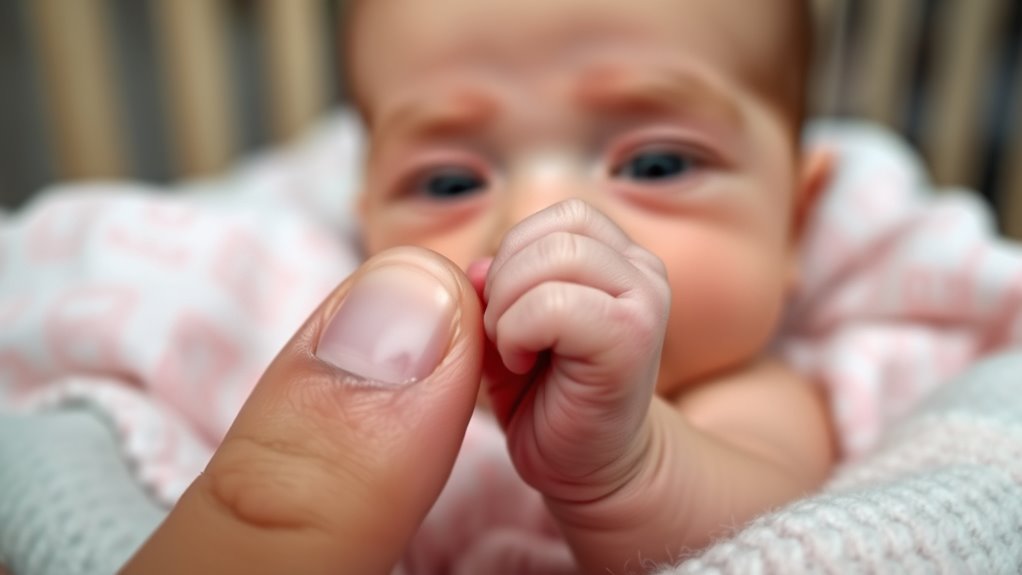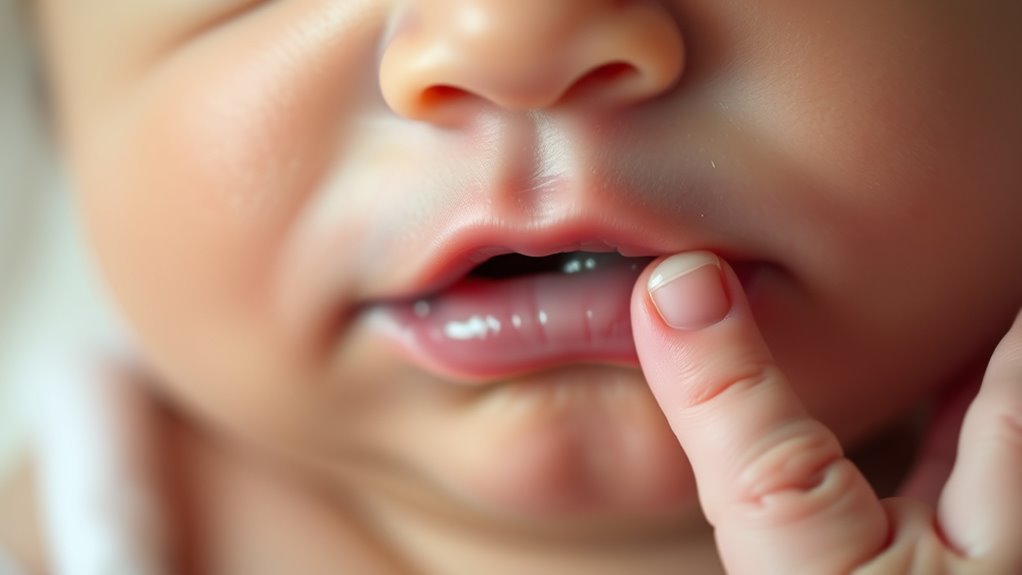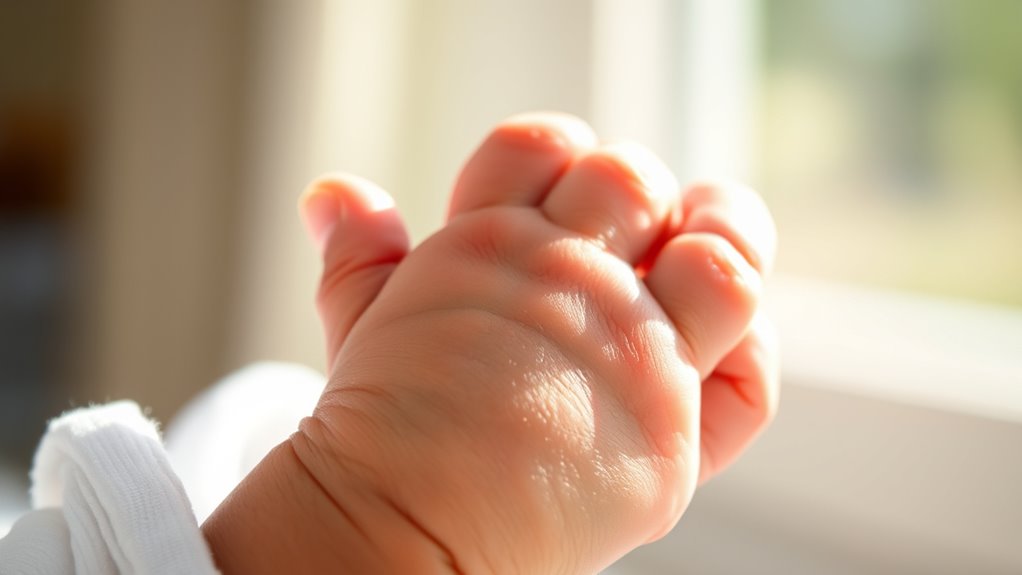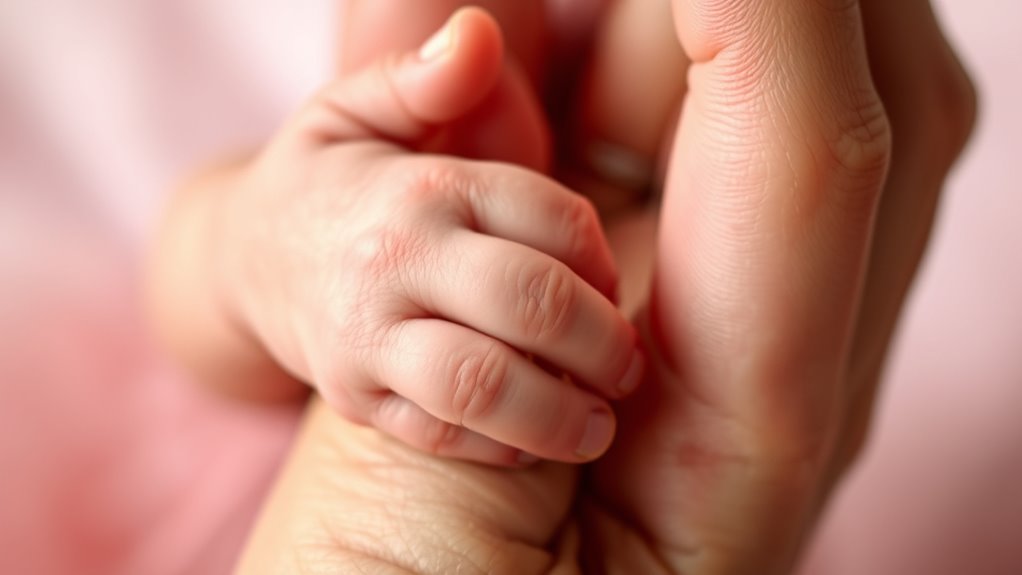Newborn reflexes are essential for your baby’s survival and growth. These involuntary actions, like the rooting and sucking reflexes, help them find food and feed effectively. Other reflexes, such as the Moro reflex and grasping reflex, provide key insights into their development. Monitoring these reflexes can reveal if any issues arise. If you keep exploring, you’ll uncover more about the fascinating ways your newborn’s behaviors support their early development.
Key Takeaways
- Newborn reflexes are involuntary actions crucial for survival, including rooting and sucking, which aid in feeding.
- The rooting reflex helps babies locate food by turning their head when their cheek is stroked.
- The sucking reflex is triggered by mouth stimulation, enabling feeding and developing coordination in sucking, breathing, and swallowing.
- Other common reflexes include the Moro reflex, grasping reflex, and tonic neck reflex, indicating neurological maturity and development.
- Monitoring these reflexes is important; asymmetry or persistence beyond typical age ranges may signal developmental concerns requiring medical attention.
Understanding Newborn Reflexes

Understanding newborn reflexes is essential for recognizing how these automatic responses play an important role in a baby’s survival and growth.
These involuntary muscle actions, like the rooting reflex, help your baby locate food by turning their head and making sucking movements when their cheek is stroked. Additionally, engaging in activities such as newborn bath time can enhance sensory experiences, promoting further development. Development influenced by biological, cognitive, and social factors contributes to the effectiveness of these reflexes as they emerge.
The Moro reflex, or startle reflex, causes your baby to extend their arms and then retract them, peaking in the first month and fading by two months.
The Moro reflex, or startle reflex, prompts your baby to extend and retract their arms, peaking in the first month.
Additionally, the grasp reflex activates when you stroke their palm, prompting a tight grip. This reflex diminishes as they gain voluntary control, usually disappearing by three months.
Each of these reflexes contributes to important developmental milestones in your baby’s early life. Understanding emotional stability during these early months is crucial for fostering a secure attachment as they grow.
The Rooting Reflex

The rooting reflex plays an essential role in helping your newborn find nourishment. When you stroke their cheek, they instinctively turn their head, making it easier for them to latch onto the breast or bottle. This reflex is an important step in their journey toward voluntary feeding behaviors as they grow. Additionally, understanding your baby’s financial behaviors can help you prepare for future expenses related to their care. The rooting reflex is crucial for infant feeding as it facilitates the baby’s ability to feed effectively. Engaging with toys that promote sensory processing can further enhance your baby’s developmental journey.
Importance in Feeding
When a baby’s cheek or mouth is stroked, the rooting reflex kicks in, allowing them to instinctively turn their head and search for the nipple. This reflex is crucial for feeding, as it helps your newborn latch onto the breast or bottle, ensuring they can obtain the nourishment they need. The importance of effective co-parenting communication can also play a significant role in how parents manage feeding schedules and routines during this time. Establishing a consistent feeding routine can provide stability for children, which is essential during early development.
The movements you’ll notice are side-to-side at first, gradually becoming more precise as your baby learns to suck. Healthcare providers routinely assess this reflex to confirm your baby’s feeding capability, as it’s a key indicator of their survival instincts. Additionally, understanding the importance of long-term financial planning can help parents prepare for their child’s future needs.
While the rooting reflex typically diminishes around four months, it plays an essential role in those early weeks, helping establish a strong feeding routine and fostering bonding between you and your baby.
Transition to Voluntary Behavior
As your baby grows, the rooting reflex evolves into more intentional actions, allowing them to actively seek out nourishment.
Initially, this reflex helps newborns locate the nipple by prompting them to turn their head toward a stroked cheek or mouth. You’ll notice side-to-side movements decreasing as your baby gains control over their head and mouth positioning for sucking.
Around 4 to 6 months, the rooting reflex shifts into voluntary behavior, marking an essential milestone in developing feeding behaviors. Your baby will begin to actively latch onto a breast or bottle, showcasing their newfound voluntary control.
Healthcare providers monitor this reflex as a significant indicator of your newborn’s feeding readiness and overall neurological health, ensuring they’re on the right track. This transition aligns with the importance of emotional well-being in fostering healthy feeding practices during early development.
The Sucking Reflex

Have you ever wondered how newborns instinctively know how to feed? The sucking reflex is a crucial survival instinct that kicks in when the mouth is touched or a nipple is inserted.
This reflex has two stages: expression, where your baby compresses the breast to release milk, and milking, where the tongue moves from the areola to the nipple. As your newborn learns to coordinate sucking, breathing, and swallowing, this complex skill develops with practice.
Notably, you can even spot the sucking reflex before birth, with thumb-sucking seen during ultrasounds. As your infant grows, this involuntary response gradually shifts to a more controlled, voluntary behavior, typically fading between 6 to 12 months.
Other Common Newborn Reflexes

As you observe your newborn, you’ll notice some fascinating reflexes at play.
The Moro reflex, grasping reflex, and tonic neck reflex are just a few examples of how their body responds to stimuli.
Understanding these reflexes can give you insight into your baby’s development and coordination.
Moro Reflex Response
The Moro reflex, often referred to as the startle reflex, showcases a newborn’s instinctive response to sudden changes in their environment.
When your baby is startled or their head position shifts, you might notice their arms and legs extend briefly before retracting. This reflex peaks in the first month after birth and typically disappears by two months, serving as a vital survival reflex.
To test the Moro reflex, a healthcare provider may gently lift and then release your baby’s head, watching for the characteristic startle response.
It’s significant to mention that asymmetry in the reflex—when one side doesn’t respond like the other—should be reported to a pediatrician, as it may indicate underlying issues that require attention.
Grasping Reflex Strength
While the Moro reflex highlights a newborn’s quick response to sudden stimuli, the grasping reflex showcases another fascinating aspect of their early development. This reflex occurs when an object touches the palm of your baby’s hand, triggering an automatic grip that’s surprisingly strong.
However, it’s important to remember:
- The grasping reflex is normal in newborns and is present at birth.
- It begins to diminish around 3 to 4 months as your baby’s neurological development progresses.
- Healthcare providers monitor this reflex to assess overall health and development.
Though your baby’s grip may feel powerful, they lack the coordination to hold on securely.
Understanding these baby’s reflexes can provide insight into their growing abilities and milestones.
Tonic Neck Reflex
One of the intriguing reflexes you’ll notice in your newborn is the tonic neck reflex, often called the fencer’s reflex. When your baby turns their head to one side, the arm and leg on that side straighten, while the opposite arm and leg flex. This reflex usually appears at birth and lasts until about 4 to 5 months, showcasing your baby’s neurological maturity. It’s often more visible when your baby is calm.
| Reflex Feature | Description |
|---|---|
| Trigger | Baby turns head to one side |
| Arm Movement | Same side arm straightens, opposite flexes |
| Duration | Present until 4-5 months |
| Asymmetry Concern | If one side is more pronounced, consult a pediatrician |
Understanding these tonic neck reflexes can help you track your baby’s development!
The Tonic Neck Reflex

When a baby’s head turns to one side, you’ll notice the tonic neck reflex, also known as the fencer’s reflex, in action. This reflex causes the arm and leg on the side toward which the head turns to straighten, while the opposite arm and leg flex.
Here are three key points about the tonic neck reflex in newborn babies:
- It typically appears between birth and two months of age.
- The reflex usually disappears by four to six months as motor control develops.
- If one side is more pronounced, consult a pediatrician for evaluation.
Observing this reflex helps assess neurological development and indicates the maturation of your baby’s nervous system.
Keep an eye on those arms and legs!
The Grasping Reflex

When you see your newborn grasp your finger, you’re witnessing the powerful grasping reflex at work.
This involuntary response showcases their strength, even if they can’t control it yet.
As they grow, this reflex will fade, making way for more intentional movements and motor skills.
Grasping Strength Development
The grasping reflex, also known as the palmar grasp reflex, is an impressive demonstration of a newborn’s instinctive capabilities. When you stroke your baby’s palm, they grip tightly, often enough to support their weight. This involuntary response is strong but doesn’t last long, typically fading as they gain voluntary control around 3 to 4 months.
Here are three key points about this reflex:
- The grasping reflex is present at birth and can also be seen as the plantar grasp reflex in the toes.
- The grip can suddenly release without warning, highlighting their lack of control.
- As your baby develops, the grasping reflex will evolve into more purposeful movements and interactions with objects.
Reflex Versus Voluntary Control
While the grasping reflex showcases a newborn’s incredible instinct, it starkly contrasts with the voluntary control that develops over time.
When you touch your infant’s palm, their fingers automatically grip tightly, demonstrating this powerful reflex. It might even seem like they can support their weight, but they lack the voluntary control to do so safely.
The grasping reflex typically fades around 3-4 months as your baby starts to develop intentional movements.
Alongside the palmar grasp, the plantar grasp reflex occurs when their toes curl tightly in response to touch.
As your infant matures, you’ll notice a shift from these involuntary reflexes to purposeful reaching and grasping, marking a significant milestone in their motor development.
Importance in Motor Skills
Understanding the importance of the grasping reflex in motor skill development can give you insight into your baby’s growth. This strong automatic response is essential for several reasons:
- Foundation for Voluntary Grasping Skills: The grasping reflex lays the groundwork for your baby’s later ability to intentionally grasp objects.
- Neurological Health Assessment: Healthcare providers often evaluate the strength and symmetry of this reflex to monitor your baby’s neurological health.
- Progression in Motor Skill Development: As the grasping reflex fades around three months, your baby begins shifting to more controlled hand movements, enhancing their overall motor skills.
Recognizing these aspects can help you appreciate how early reflexes contribute to your baby’s developing abilities and overall well-being.
The Stepping Reflex

As a newborn places their feet on a flat surface, you’ll notice an instinctive stepping motion that mimics walking. This stepping reflex is more than just a cute quirk; it’s a basic survival instinct designed to help the infant crawl toward the breast right after birth.
Typically, this reflex appears at birth and lasts until about two months of age, before fading away and later re-emerging as part of learned walking behavior.
While your baby shows off this reflex, they’ll need support under their arms and head, as they lack the strength and coordination to hold themselves up.
Pediatricians often assess the stepping reflex to gauge your newborn’s motor skill development and verify their neurological function is healthy and symmetrical.
Monitoring Newborn Behavior

Monitoring your newborn’s behavior is essential for ensuring they develop properly and identifying any potential concerns early on.
Regularly observing your baby’s reflexes can provide valuable insights into their development. Here are three key areas to focus on:
- Reflex Assessment: Watch for the rooting, Moro, and grasping reflexes. Discuss any asymmetrical responses with your doctor.
- Crying Patterns: Keep a record of your newborn’s crying to help identify excessive or unusual behavior that may need medical attention.
- Vision and Hearing: Monitor your baby’s reactions to visual and auditory stimuli to catch any issues early on.
When Reflexes Disappear

Observing your newborn’s reflexes not only helps you track their development but also prepares you for when these reflexes begin to fade.
Most newborn reflexes, including the Moro and stepping reflexes, typically disappear by two months of age. As your baby grows, the grasping reflex may linger longer, usually fading between 3 to 6 months as they gain voluntary control.
The rooting reflex generally disappears around 4 to 6 months, signaling their shift to more voluntary feeding behaviors. The tonic neck reflex is expected to diminish between 4 to 5 months as motor skills and muscle control improve.
When to Contact a Healthcare Provider

When should you reach out to a healthcare provider about your newborn’s reflexes?
It’s important to monitor your baby’s behaviors closely. Here are three key situations to contemplate contacting a doctor:
- Your baby has asymmetrical reflexes, which may indicate a neurological issue.
- Your baby’s Moro reflex persists beyond two months, signaling potential developmental concerns.
- If your baby shows signs of excessive crying that lasts longer than three hours a day or seems unusual in nature.
Additionally, contact a healthcare provider if your baby doesn’t respond to sounds or track movement visually by two to three months.
Contact a healthcare provider if your baby isn’t responding to sounds or tracking movement visually by two to three months.
Addressing these concerns early can help guarantee your baby’s healthy development.
Frequently Asked Questions
What Are the Normal Newborn Reflexes and Behavior?
Newborns exhibit several normal reflexes and behaviors that are fascinating to observe.
You’ll notice the rooting reflex, where they’ll turn their head and suck when their cheek is stroked. The Moro reflex causes them to startle and extend their limbs when startled.
You might see them grasp objects tightly, and when their feet touch a surface, they’ll make stepping motions.
These reflexes are temporary, fading as they gain more voluntary control over their movements.
What Are the 7 Reflexes of a Newborn?
You’ll notice several reflexes in newborns that showcase their developing nervous system. The rooting reflex helps them find food, while the Moro reflex startles them in response to sudden movements.
They’ll grasp objects tightly due to the grasp reflex and exhibit the tonic neck reflex when their head turns. Additionally, you might see the stepping reflex as they appear to walk.
These reflexes usually fade as they grow, around 2 to 4 months.
What Are Abnormal Movements in Newborns?
Abnormal movements in newborns can include persistent asymmetry in their responses, where one side doesn’t react like the other.
You might notice sudden jerking movements that seem uncontrolled, possibly indicating seizures. If you see consistent trembling unrelated to crying, it’s worth discussing with a healthcare provider.
Additionally, watch for extreme stiffness or floppiness in their body, as these can signal developmental concerns.
Always consult a pediatrician if you notice anything unusual.
Why Are Babies Born With so Many Reflex Behaviors?
They say, “Nature knows best,” and that’s certainly true when it comes to babies and their reflex behaviors.
You’ll find that these instincts are vital for survival, helping infants feed and respond to their environment. Each reflex, from grasping to rooting, plays an important role in their development.
These involuntary actions guarantee they adapt and thrive in the world, laying the groundwork for future voluntary movements as they grow.
Conclusion
In summary, understanding your baby’s reflexes is like revealing a secret language of their development. These instinctive behaviors, from rooting to stepping, provide insight into their growth and well-being. Keep an eye on these reflexes as they evolve, and don’t hesitate to reach out to a healthcare provider if you notice anything concerning. By staying informed and attentive, you’ll help your little one thrive during those precious early days. Remember, every reflex tells a story!









